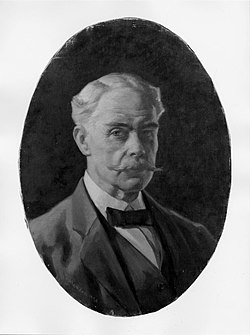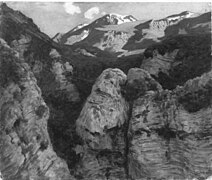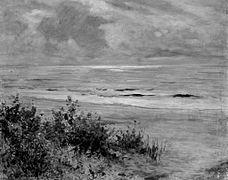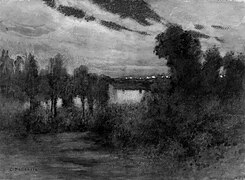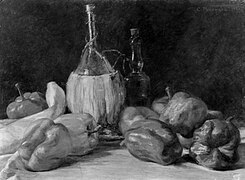Carlo Pollonera
| Naissance | |
|---|---|
| Décès | |
| Nationalité | |
| Formation | |
| Activités |
| Genre artistique | |
|---|---|
| Abréviation en zoologie |
Pollonera |
Carlo Pollonera, né le à Alexandrie et mort le à Turin, est un peintre italien, en particulier de paysages, mais également un important malacologue.
Biographie
[modifier | modifier le code]Le père de Carlo Pollonera, Giovanni B. Pollonera, est avocat à Alexandrie[2]. Il meurt quand Carlo est un enfant, après quoi sa mère retourne en Italie à Gênes et se remarie[3],[4]. À l'âge de dix-sept ans, Carlo combat avec Garibaldi lors de la campagne du Trentin en 1866[5]. En 1865, la famille s'installe à Turin, où Pollonera commence à étudier la peinture avec Alberto Maso Gilli. Il s'inscrit à l'Accademia Albertina et étudie avec Gamba et Andrea Gastaldi. Pollonera, élève rebelle, veut peindre exactement ce qu'il voit, plutôt que, par exemple, de changer un arrière-plan gênant. Ce principe de ne pas améliorer ce qu'il voit reste une marque de fabrique de sa peinture tout au long de sa carrière[6]. Après quatre ans chez Gastaldi, en 1873, il fréquente l'école privée d'Antonio Fontanesi[6],[2]. En janvier 1875, il voyage avec son ami proche Carlo Stratta à Paris, où il étudie auprès de Thomas Couture et est influencé par l'école de Barbizon[7]. Il se rend également à Milan en 1874 et à Rome entre 1900 et 1912, où il s’ associe avec Antonio Mancini, Pietro Canonica et John Singer Sargent[8],[9]. Ses joueurs de cartes, une de ses premières œuvres, est exposée au Promotrice de Turin en 1873, où il expose ensuite régulièrement[10]. Parmi ses œuvres on peut citer : Canavese ; Aprile ; Le oche ; Tranquillità ; Il ballo ; La métisse ; Terrena Fiorito et Il Malone. En 1882, il expose le portrait entier d' Il seminatore[11]. Certains de ses tableaux sont aujourd'hui évalués à des milliers, voire des dizaines de milliers d'euros[12],[13].
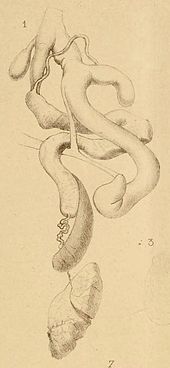
Enfant, Pollonera devient le beau-fils de l'éminent naturaliste et sénateur Michele Lessona, dont la seconde épouse (la mère de Pollonera, Adele Masi Lessona) et les enfants sont très impliqués dans sa production scientifique, en particulier les traductions[4],[15]. Bien que Pollonera ait commencé à étudier les sciences naturelles, il se tourne rapidement vers la peinture[6]. Néanmoins de 1882 à 1916 Pollonera écrit plus de 50 articles scientifiques sur les mollusques non marins[2],[4],[16]. Voir sa page bibliographique. La plupart des articles sont écrits en italien pour des revues italiennes, mais il y a aussi des articles écrits en français, anglais, portugais et allemand pour des revues de ces pays. Sa production atteint son apogée dans la décennie 1884-1893, alors qu'il travaille sur la faune de l'Italie et des régions adjacentes ; seulement 16 articles sont apparraissent après 1898, quand son attention se porte davantage sur la faune de l'Afrique. La première publication de Pollonera est une monographie sur les limaces italiennes en collaboration avec son demi-frère cadet Mario Lessona[17], mais par la suite il en est toujours le seul auteur. Cependant, la section ci-dessous sur les taxons nommés d'après Pollonera fournit de nombreux exemples de coopération généreuse avec d'autres scientifiques, parfois en rédigeant des descriptions d'espèces dans d'autres documents ou en dessinant les plaques. Alors que certains de ses articles sont des recueils de brèves notes sur des sujets disparates[18], d'autres sont des monographies faisant autorité sur des taxons particuliers[19], son nécrologue Colosi[2] souligne que ses descriptions approfondies et bien observées des espèces étaient appréciées même par ceux qui ne partageaient pas ses conclusions sur la systématique. Son talent d'artiste se manifeste également dans les planches illustrant ses articles (voir exemples ci-dessous). Un aspect particulièrement important de ses recherches est qu'il dissèque les animaux pour leur donner des caractères anatomiques supplémentaires, ce qui devient la norme depuis, mais qui était à l'époque une approche de pointe[16],[20]. Cette approche est particulièrement utile pour étudier les limaces, qui est le groupe sur lequel il publie le plus , bien que ses autres articles concernent les escargots terrestres et parfois l'eau douce et des fossiles. Sa collection se trouve au Museo Regionale di Scienze Naturale di Torino[21].
Pendant 20 ans, Pollonera entretient une relation avec une pianiste, dont le nom est aujourd'hui perdu; c'est une des raisons pour lesquelles il reste à Turin. Mais en 1913, Pollonera épouse Ulma de'Bartolomeis (1886-1981), 37 ans sa cadette, qui avait suivi des cours privés de peinture avec lui[6]. On sait qu'ils ont parfois travaillé ensemble sur la même toile[22]. Il n'a qu'une seule fille, Sabina (1914-1996). Carlo Pollonera meurt le 17 juin 1923 après un court passage à l'hôpital San Giovanni de Turin[6].
Pollonera n'était pas un chrétien pratiquant mais croyait en un être supérieur. Marziano Bernardi a résumé son personnage comme "silencieux et solitaire par nature, rebelle et intransigeant" ("un silenzioso e un solitario per temperamento, un ribelle e un intransigente"). Une anecdote frappante est que les commentaires du critique littéraire et peintre Enrico Thovez sur la perspective d'une des peintures de Pollonera ont amené Pollonera à proposer un duel ! Au lieu de cela, l'affaire a été réglée en cour, et les deux protagonistes ont par la suite inventé[6].
Taxons nommés d'après Pollonera
[modifier | modifier le code]Texte anglais à traduire :
The list of taxa that have been named after Pollonera documents not only the esteem in which he was held but also the milieu of his scientific contacts as his influence spread.
The first to name a species after Pollonera was his half-brother Mario Lessona, who described the land snail Clausilia pollonerae in 1880[23]. The only locality he listed is one reported by Pollonera. The name is now considered a synonym of Charpentieria dyodon thomasiana[24].
In 1884, the geologist Federico Sacco named a Pliocene freshwater snail Viviparus pollonerae, dedicated to this "kind and talented malacologist" ("al gentile quanto valente malacologo")[25]. Sacco also acknowledged Pollonera's help with his work: the two were contemporaries in Turin. In 1886, Sacco named a species of slug known only from its fossil shell (Miocene) as Limax pollonerae after his colleague who "so lovingly deals with the study of Limacidae" ("con tanto amore si occupa dello studio dei Limacidi")[26]. The same year, Sacco coined the name Polloneria for a subgenus of the land snail genus Clausilia, naming it after "one of the most illustrious Italian malacologists"[27]; Polloneria has since been raised to the rank of genus and given rise to the name of the tribe Polloneriini[28]. In the same article Sacco described Ferussacia Pollonerae. Other colleagues in Turin were responsible for the only two non-molluscan species named after Pollonera. In 1896, Achille Griffini named an orthopteran from Central America Cocconotus Pollonerae (now in the genus Eubliastes)[29]. And in 1912, Lorenzo Camerano named a horsehair worm Chordodes pollonerae[30]; Camerano was originally, like Pollonera, a painter, who had become a protégé of Pollonera's step-father Michele Lessona, eventually taking his place as head of the Turin museum, becoming a senator, and also marrying Pollonera's half sister Luigia[31],[15].
Meanwhile, Napoleone Pini, based in Milan, had named two species after Pollonera in different 1885 articles printed in the same volume: one was the snail Pupa pollonerae (now Orcula spoliata)[32] and the other the slug Arion pollonerae[33]. In the first case, it was Pollonera who had passed on the specimens of the "new" species to Pini and, in the second, he had drawn the plates illustrating the article. In 1888, another Italian malacologist Giorgio R. Sulliotti, used the name Polloneria for a genus of sea butterfly[34]. As Sacco had used the name already, this new use was invalid and the older name Heliconoides is used today. A year later Sulliotti named a marine bivalve from Sardinia Tapes Pollonerianus in honour of Pollonera "to whom we owe the most recent and best study of the malacological fauna of Piedmont, and with whose friendship I am honored"[35]. Sullioti compared this form with the common Ruditapes decussatus, from which it is not now distinguished.
Pollonera's work and reputation had now begun to spread beyond Italy. In 1889, the German slug specialist Heinrich Simroth named a species of slug from Palermo Agriolimax Pollonerae[36]. This is today considered a synonym of Deroceras panormitanum[37], which Lessona and Pollonera had already described in 1882, also from Palermo[17]. In 1890, another German, Karl Flach, better known as an entomologist, named a variety of Pupa biplicata as "Pollonerae", having discussed Pollonera's recent work on this species[38],[39]. The Swedish malacologist Carl Westerlund in 1892 named a soil-living snail from Malta Cionella pollonerae[40]; this is today considered a synonym of Cecilioides acicula.
Two expeditions led by Borelli to Paraguay and Argentina yielded mollusc collections that Giuseppe Paravicini (of Milan) and then César Ancey (working in Algeria) wrote up in 1894 and 1897[41],[42]. Each named a snail species after Pollonera: Helix Pollonerae (now in the genus Epiphragmophora) and Bulimulus Pollonerae. Ancey thanked Pollonera for having directed the collection to him.
In 1897, the cleric and malacologist Pietro Arbanasich (using the pseudonym Fra Piero) authored the description of a species of semi-slug from Sardinia under the name Vitrina Polloneriana[43]. Really, Pollonera himself wrote and illustrated the description[44], and one might suppose that the naming was Arbanasich's way of thanking him. Current names in use for this species are Oligolimax pollonerianus and Sardovitrina polloneriana[45].
In his large 1903 monograph on the Corsican non-marine mollusc fauna, the French soldier-turned-malacologist Eugène Caziot named a variety of Helix raspaili as pollonerae (now Tacheocampylaea acropachia pollonerae)[46], acknowledging the considerable help of the "Italian dissector"[47]. The collaboration was close enough that Pollonera is given as the authority for another new species described in the work.
The leading North American malacologist Henry Pilsbry named two species after Pollonera in his major 1919 work on molluscs from the Belgian Congo, the slug Trichotoxon pollonerae and the snail Gulella polloneriana[48]. The latter was most likely so named because of its resemblance to G. camerani, which had been described by Pollonera. Ptchotrema pollonerae is another species of landsnail from the Belgian Congo, this one named in 1913 by Hugh Preston[49], a shell dealer in London who "realized the market value of new names"[50].
Pollonera was commemorated even after his death. In 1939, Polloneria was used a third time, this time by Alonza and Alonza Bissachi, for a subgenus of unrelated hygromiid snails[51], The next year, to avoid the homonym, they replaced the name with Polloneriella[52],[53]. Polloneriella is nowadays sometimes considered as a montoypic genus[54] or sometimes considered a subgenus of Xerosecta[55].
![]() Signature: p. 162 of Taylor (1905)[1]. See [10] for other examples.
Signature: p. 162 of Taylor (1905)[1]. See [10] for other examples.
Traduction du texte anglais :
proposition de traduction
Galerie
[modifier | modifier le code]Quelques peintures de Pollonera à la Galleria Civica d'Arte Moderna e Contemporanea, Turin
[modifier | modifier le code]Les titres et les dates suivent ceux d'Aldo Picco[6]
|
|
Exemples de planches dessinées par Pollonera illustrant ses articles malacologiques
[modifier | modifier le code]
|
|
Notes et références
[modifier | modifier le code]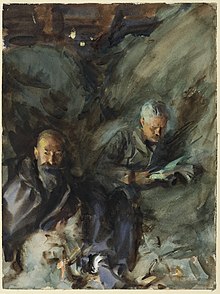
- (en) Cet article est partiellement ou en totalité issu de l’article de Wikipédia en anglais intitulé « Carlo Pollonera » (voir la liste des auteurs).
- Taylor, J.W., Monograph of the land and freshwater Mollusca of the British Isles. Part 11., Leeds, Taylor Brothers, (DOI 10.5962/bhl.title.13226)
- Colosi, G., « Carlo Pollonera. », Bollettino dei Musei di Zoologia ed Anatomia comparata della R. Università di Torino, vol. 38, no 14, , p. 1–6
- Govoni, di P., Verrucci, G., « Lessona, Michele: Dizionario Biografico degli Italiani – Volume 64 (2005) », Treccani, l'enciclopedia italiana (consulté le )
- Pallary, P., « C. Pollonera », Journal de Conchyliologie, vol. 68, , p. 170–172 (lire en ligne)
- Bosio, P., « Carlo Pollonera: pittore di montagna », La Rivista della Giovane Montagna, vol. 10 (issues 6, 7, 8) pp. 127–129, 155–158, 185–187 + plates following pp. 124 and 172, (lire en ligne)
- Picco, A., Carlo Pollonera, Turin, Umberto Allemandi,
- Site Arte Piemonte , biographie de MLRdv.
- Renzo Guasco, Carlo Pollonera, Turin, Galleria civica d'arte moderna—Torino,
- « Pollonera, Carlo », Berman: Galleria e Libreria d'arte (consulté le )
- Biographie de l' Istituto Matteucci de Dizionario degli artisti , organisée par Cristina Bonagura, partie de l'œuvre de Pittori & pittura dell'Ottocento italiano (1996–1997), coordonnée par Giuliano Matteucci avec la collaboration de Paul Nicholls et complétée par le Redazioni Grandi Opere dell ' Istituto Geografico De Agostini.
- Tableau des artistes italiens Viventi: pittori, scultori, et Architetti [1] , d'Angelo de Gubernatis. Tipe dei Successori Le Monnier, 1889, page 384.
- Sotheby's, « Carlo Pollonera: Primavera in Ligura » (consulté le )
- « Oldpaintings.net » (consulté le )
- Pollonera, C., « Sulla classificazione dei Limacidi del sistema europeo », Bollettino dei Musei di Zoologia ed Anatomia Comparata della Reale Università di Torino, vol. 2, no 23, , p. 1–6 + pl. 3 (lire en ligne)
- (it) A. Drösche, « Scienza a due voci: le donne nella scienza italian dal settecento al novecento. Masi Lessona Adele », sur unibo.it, Alma Mater Studiorum - Università di Bologna (consulté le )
- Hesse, P., « Carlo Pollonera. », Archiv für Molluskenkunde, vol. 56, no 4, , p. 179–180
- Lessona, M., Pollonera, C., Monografia dei limacidi italiani, Turin, Loescher, , 1–82, Pls 1–3
- Pollonera, C., « Note malacologiche », Bollettino dei Musei di Zoologia ed Anatomia Comparata della Reale Università di Torino, vol. 24, no 608, , p. 1–19 + 1 pl. (lire en ligne)
- Pollonera, C., « Monografia del genere Vitrina », Atti della Reale Accademia delle Scienze di Torino, vol. 19, no 3, , p. 322–342 + pl. 10 (lire en ligne)
- Collinge, W.E., « On some European slugs of the genus Arion », Proceedings of the Zoological Society of London, vol. 65, no 3, , p. 439–450 + pl. 29–31 (DOI 10.1111/j.1096-3642.1897.tb03102.x)
- Bodon, M, Manganelli, G., Giusti, F., « A survey of the European valvatiform hydrobiid genera, with special reference to Hauffenia Pollonera, 1898 (Gastropoda, Hydrobiidae) », Malacologia, vol. 43, , p. 103–215 [see page 122]
- Anonymous, Asta 100, Genoa, Cambi Case d'Aste, , 1–227 [see page 191] (lire en ligne)
- Lessona, M., Molluschi viventi del Piemonte, Rome, Salviucci, , 1–66 + pl. 1–4 (lire en ligne)
- Muséum national d'Histoire naturelle [Ed]., « National Inventory of Natural Heritage » (consulté le )
- Sacco, F., « Nuove specie fossili di molluschi lacustri e terrestri in Piemonte », Atti della Reale Accademia delle scienze di Torino, vol. 19, , p. 247–264 + pl. 8 (lire en ligne)
- Sacco, F., « Nuove specie terziarie di molluschi terrestri d'acqua dolce e salmastra del Piemonte », Atti della Societa Italiana di Scienze Naturali, vol. 29, , p. 427–476 + table + pl. 13–14 (lire en ligne)
- Sacco, F., « Fauna malacologica delle alluvione plioceniche del Piemonte », Memorie della Reale accademia delle scienze di Torino, Series 2, vol. 37, , p. 169–206 + Pl. 1–2 (lire en ligne)
- Nordsieck, H., Worldwide door snails (Clausilidae), recent and fossil, Hackenheim, Conch Books, , 214 p. (ISBN 978-3-939767-07-7)
- Griffini, A., « Ortotteri raccolti nel Darien dal dott. E. Festa », Bollettino dei Musei di Zoologia ed Anatomia Comparata della Reale Università di Torino, vol. 11, no 232, , p. 1–32 (lire en ligne)
- Camerano, L., « Chapter 19. Gordiens du Musée Indien. Nouvelle Series », Records of the Indian Museum, vol. 7, no 3, (lire en ligne)
- Zavattari, E., Enciclopedia Italiana : Camerano, Lorenzo, (lire en ligne)
- Pini, N., « Novità malacologiche. II. Nota », Atti della Società Italiana di Scienze Naturali, vol. 27, , p. 368–383 + Pl. 12 (lire en ligne)
- Pini, N., « Note malacologiche sulla fauna Italiana », Atti della Società Italiana di Scienze Naturali, vol. 27, , p. 79–86 (lire en ligne)
- Sullioti, G.R., « Osservazioni intorno ai Generi Heliconoides, D' Ori), e Thapsia, Monts. », Bollettino del naturalista: collettore, allevatore, coltivatore, vol. 8, no 5, , p. 66–67 (lire en ligne)
- Sullioti, G.R., « Comunicazioni malacologiche: articolo primo », Bullettino della Società malacologica italiana, vol. 14, , p. 25–48 (lire en ligne)
- Simroth, H., « Beiträge zur Kenntnis der Nacktschnecken », Nachrichtsblatt der Deutschen Malakozoologischen Gesellschaft, vol. 21, , p. 177–186 (lire en ligne)
- Reise, H., Hutchinson, J. M. C., Schunack, S., Schlitt, B., « Deroceras panormitanum and congeners from Malta and Sicily, with a redescription of the widespread pest slug as Deroceras invadens n. sp », Folia Malacologica, vol. 19, no 4, , p. 201–223 (DOI 10.2478/v10125-011-0028-1)
- Flach, K., « Palaeontologische Beiträge », Verhandlungen der Physikalisch-medicinischen Gesellschaft zu Würburg, vol. 24, , p. 49–59 + pl. 1 (lire en ligne)
- Pollonera, C., « Note malacologiche », Bollettino della Società Malacologica Italiana, vol. 12, , p. 204–223+ pl. 6 (lire en ligne)
- Westerlund, C.A., « Spicilegium malacologicum. Neue Binnen-Conchylien in der paläarktischen Region. III », Nachrichtsblatt der Deutschen Malakozoologischen Gesellschaft, vol. 24, nos 11/12, , p. 185–201 (lire en ligne)
- Paravicini, G., « Viaggio del dottor Alfredo Borelli nella Republica Argentina e nel Paraguay. IV. Molluschi », Bollettino dei Musei di Zoologia ed Anatomia Comparata della Reale Università di Torino, vol. 9, no 181, , p. 1–10 (lire en ligne)
- Ancey, C.F., « Viaggio del Dott. Alfredo Borelli nel Chaco boliviano e nella Republica Argentina. XI. Resultats malacologiques accompagnés d'une notice sur les espèces précédemment recueillies par ce voyageur », Bollettino dei Musei di Zoologia ed Anatomia Comparata della Reale Università di Torino, vol. 12, no 309, , p. 1–22 + 1 pl. (lire en ligne)
- Fra Piero [=Arbanasich, P.], « Nota sui limacidi in Sardegna a proposito di una nuova specie di Vitrina », Annuario del Club Alpino Sardo, vol. 4, , p. 65–75 + pl.
- Welter-Schultes, F.W., « Species summary for Vitrina polloneriana, version 04.052012 », www.animalbase.uni-goettingen.de (consulté le )
- Manganelli, G., Giusti, F., « The status and relationships of Vitrina polloneriana Fra' Piero, 1897, with description of Sardovitrina n. gen. (Gastropoda: Pulmonata: Vitrinidae) », Journal of Conchology, vol. 38, , p. 567–580
- Falkner, G., Ripken, T.E.J., Falkner, M., « Mollusques continentaux de France. Liste de Référence annotée et Bibliographie », Patrimoines naturels, vol. 52, , p. 1–350 (ISBN 978-2-85653-539-4)
- Caziot, E., « Étude sur la faune des mollusques vivants terrestres et fluviatiles de l'Île de Corse », Bulletin de la Société des sciences historiques et naturelles de la Corse, vol. 22, nos 266–269, , p. 1–354 + pl. 1–2 (see p. 120) (lire en ligne)
- Pilsbry, H.A., Land, H. et Bequaert, J., « A review of the land mollusks of the Belgian Congo chiefly based on the collections of the American Museum Congo Expedition, 1909–1915 », Bulletin of the American Museum of Natural History, vol. 40, , p. 1–370 + pl. 1–23 (lire en ligne)
- Preston, H.B., « Diagnoses of new species and varieties of agnathous Mollusca from equatorial Africa », Proceedings of the Zoological Society of London, vol. 1913, , p. 194–218 + pl. 32–35 (lire en ligne)
- Winckworth, R., « Hugh Berthon Preston, 1871–1945 », Proceedings of the Malacological Society of London, vol. 27, no 1, , p. 4–5 (DOI 10.1093/oxfordjournals.mollus.a064488)
- Alzona, C., Alzona Bisacchi, J., Malacofauna italica. Vol. I, Gênes, Quinto al Mare, , 129–152 p.
- Alzona, C., Alzona Bisacchi, J., Malacofauna italica. Vol. I, Gênes, Quinto al Mare, , 153–170 p.
- Manganelli, G., Giusti, F., « Notulae malacologicae, XXXVIII. A new Hygromiidae from the Italian Apennines and notes on the genus Cernuella and related taxa (Pulmonata: Helicoidea) », Bollettino Malacologico, vol. 23, , p. 327–379
- Giusti, F., Manganelli, G., « Ichnusomunda sacchii, a new hygromiid snail from Sardinia Island (western Mediterranean): an intriguing case of homoplasy in the anatomical organization (Pulmonata: Hygromiidae) », Veliger, vol. 41, , p. 319–332 (lire en ligne)
- Welter-Schultes, F.W., European non-marine molluscs, a guide for species identification, Gœttingue, Planet Poster Editions, , 679 p. (ISBN 978-3-933922-75-5)
- Pollonera, C., « Appunti di malacologia. IV. Intorno ad alcuni Limax italiani », Bollettino dei Musei di Zoologia ed Anatomia Comparata della Reale Università di Torino, vol. 3, no 51, , p. 1–4 + pl. 3 (lire en ligne)
- Pollonera, C., « Note su alcuni grupi di specie del genere Xerophila. Sul grupo della X. subprofuga », Bollettino dei Musei di Zoologia ed Anatomia Comparata della Reale Università di Torino, vol. 7, no 128, , p. 1–18 (lire en ligne)
- Pollonera, C., « Nuove contribuzioni allo studio degli Arion europei », Atti della Reale Accademia delle Scienze di Torino, vol. 24, no 13, , p. 401–418 + pl. 9 (lire en ligne)
- Anonymous, « In a Hayloft », Brooklyn Museum (consulté le )
Annexes
[modifier | modifier le code]Article connexe
[modifier | modifier le code]Liens externes
[modifier | modifier le code]- Ressources relatives aux beaux-arts :



